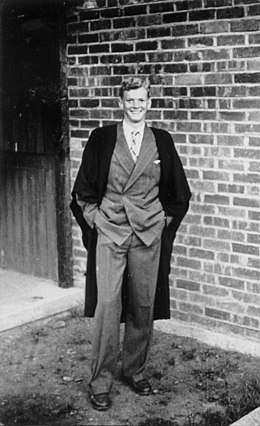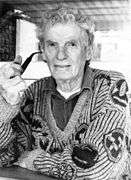Cuan McCarthy
Cuan Neil McCarthy (24 March 1929 – 14 August 2000) was a South African cricketer who played in fifteen Tests from 1948 to 1951.
 | ||||||||||||||||||||||||||||||||||||||||
| Personal information | ||||||||||||||||||||||||||||||||||||||||
|---|---|---|---|---|---|---|---|---|---|---|---|---|---|---|---|---|---|---|---|---|---|---|---|---|---|---|---|---|---|---|---|---|---|---|---|---|---|---|---|---|
| Born | 24 March 1929 Pietermaritzburg, Natal, South Africa | |||||||||||||||||||||||||||||||||||||||
| Died | 14 August 2000 (aged 71) Johannesburg, Transvaal, South Africa | |||||||||||||||||||||||||||||||||||||||
| Height | 6 ft 2 in (1.88 m) | |||||||||||||||||||||||||||||||||||||||
| Batting | Right-hand bat | |||||||||||||||||||||||||||||||||||||||
| Bowling | Right-arm fast | |||||||||||||||||||||||||||||||||||||||
| International information | ||||||||||||||||||||||||||||||||||||||||
| National side | ||||||||||||||||||||||||||||||||||||||||
| Career statistics | ||||||||||||||||||||||||||||||||||||||||
| ||||||||||||||||||||||||||||||||||||||||
Source: Cricinfo | ||||||||||||||||||||||||||||||||||||||||
Life and career
One of five children born to Victor and Phyllis McCarthy, Cuan McCarthy grew up on "Glenaholm", a citrus and poultry farm just out of Pietermaritzburg, where his mother bred a famous line of Rhodesian Ridgeback dogs (Glenaholm Kennel). He received his secondary education at Maritzburg College.
Cuan McCarthy was included in the national side for the first time at the age of 19. Six feet two inches (1.88m) tall,[1] and a bowler of genuine pace who could command a deadly off-cutter,[2] he opened the bowling for South Africa in his 15 Tests, spanning 1948 to 1951. He was no batsman and stands as one of the few cricketers who have taken more wickets than they scored runs: up to the end of 1951 his highest score in forty-five first-class games was only seven. On a pitch freshened by a sharp shower[3] he produced his best bowling figures in his debut Test against the touring English team on his home turf at Kingsmead, taking six wickets for 43 runs in the second innings.[4] In later games it was thought that he too often pitched short when he would have been deadly bowling to a much fuller length. This tendency was seen at its worst in the 1951 tour of England, especially on an extremely difficult pitch at Old Trafford.[5]
The following year, McCarthy moved to Pembroke College, Cambridge,[6] and was viewed as a valuable acquisition by the cricketing press. He bowled extremely well in taking forty-four wickets for the University at an average cost of little over seventeen each,[7] but a controversy arose when at Worcester McCarthy became the first bowler to be no-balled for throwing in English first-class cricket since 1908. He was still allowed to bowl for the rest of the match, and was thought so good that he played for the Gentlemen at Lord's and Scarborough, without meeting with pronounced success.
Although at this point McCarthy was established as a major bowling force, it turned out that he was never to be seen again in first-class cricket. After being at Cambridge in 1952, McCarthy stayed on in England[8] but was still thought a candidate for the 1952/1953 tour of Australia. However, he was not chosen and his only later cricket was in the Minor Counties Championship for Dorset, where he settled in subsequent years before returning to South Africa as a farmer.[9]
Personal life
He married Margaret Gillian Trotter (*16 August 1930 Kloof) on 30 January 1954 and they produced a family of 3 children - Philippa Jane (*1955 Epsom, England), Nicholas Hewlett (*1958 Dorset, England) and Sarah Victoria (*1964 Dorset, England). In 1972 he married Valerie Joan Parham (1936-1985) from Rhodesia and they had a son Angus Neil Cuan (*1973 Harare).
.jpg) Cuan McCarthy and wife Gillian 1954
Cuan McCarthy and wife Gillian 1954 Cuan McCarthy in later life
Cuan McCarthy in later life
References
- Louis Duffus, "The South Africans", The Cricketer, Spring Annual 1951, pp. 5–9.
- Wright, Graeme (editor); Wisden Cricketers' Almanack, 138th edition (2001); p. 1594; ISBN 0-947766-63-4
- Giller, Norman; "Bedser and Gladwin scurry to thrilling last-ball victory"; in The World's Greatest Cricket Matches; pp. 17-19. ISBN 0-7064-3895-7
- "1st Test: South Africa v England at Durban, Dec 16-20, 1948". espncricinfo. Retrieved 13 December 2011.
- Preston, Norman (editor); Wisden Cricketers' Almanack, 89th edition (1952); p. 210
- "Cricket". The Times (52320). London. 24 May 1952. p. 4.
- Preston, Norman (editor); Wisden Cricketers' Almanack, 90th edition (1953); pp.642-643
- Webber, Roy; The Playfair Book of Test Cricket, Volume II; p. 23. Published June 1953 by Welbecson Press Limited.
- Wright; Wisden Cricketers' Almanack (2001); p. 1594